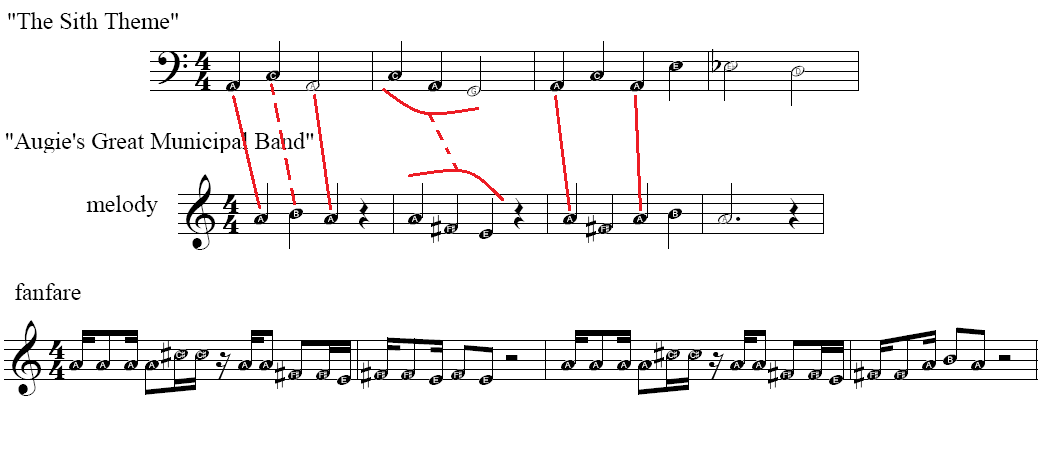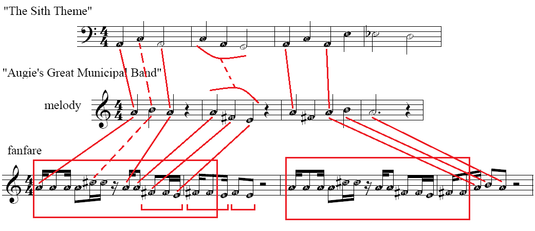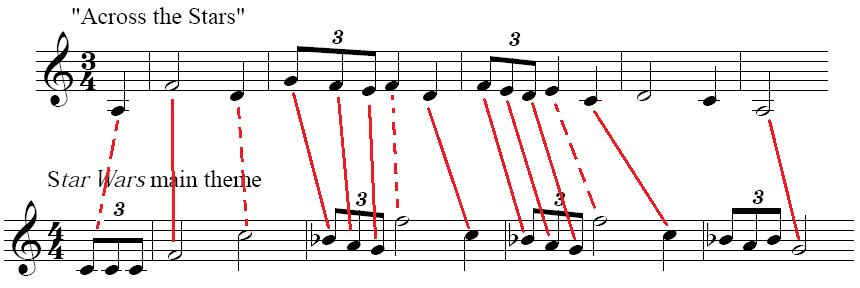|
"Augie's Great Municipal Band", which concludes The Phantom Menace, is very strongly related to "The Sith Theme", as first heard in Return of the Jedi. "Augie's" contains two primary musical components: the melody (sung by children's chorus) and the fanfare (played by trumpets) - both of which are directly derived from "The Sith Theme". The first measure of both "The Sith Theme" and the "Augie's" melody contain three notes, the first and last of which are the same, the middle of which is comparable. The second measure of both then use different notes, but share intervallic contour (down a minor third, down a major second). The second half of the themes have less in common, although they both do use the tonic note on beats 1 and 3 of the third measure. The "Augie's" fanfare, then, adopts a similar relationship to "The Sith Theme" for its beginning (first and third notes identical, with second note comparable), followed by the same intervallic pattern (descending minor third, descending major second). Those last two notes (F# and E) are then repeated twice (so heard a total of three times - indicated in brackets at the bottom of the example below) using different fanfare rhythms. The second half of the fanfare uses a copy/paste repetition of the first 13 notes (indicated with the large rectangles in the example below), with the final three tones matching up pitches with the "Augie's" melody. The use of the modified "Sith Theme" at the conclusion of The Phantom Menace musically illustrates the true (if behind-the-scenes) victor of the film: Senator Palpatine has just been promoted to Supreme Chancellor, and it's only a matter of time before he declares himself emperor and reveals his secret identity as a Sith lord.
4 Comments
The four notes that conclude "Anakin's Theme" are nearly identical to the opening few notes of "The Imperial March", sharing pitches, intervals, and contour, and differing only in rhythm (and only slightly at that) and character ("Anakin's Theme", of course, doesn't have the ominous power that "The Imperial March" has). This connection is made very clear during the end credits of The Phantom Menace, in which John Williams repeats those last few notes several times in a row, as if to say, "In case you missed the foreshadowing, here it is again!" This can be heard in the YouTube video below around 7:45. I have discovered much internet forum discussion over whether or not "Across the Stars", the love theme from Attack of the Clones, is an inversion of the Star Wars main theme. Rather similar to my 2014.04.22 blog re: the Star Wars main theme being an inversion of "Born Free", this blog will be a side-by-side study and comparison of the two themes to see if there really is any truth to the notion. Here's the main theme inits original form. Click here to listen. Here's the main theme chromatically inverted. Click here to listen. Here's the main theme diatonically inverted. Click here to listen. Now compare those with "Across the Stars". Here's "Across the Stars" in its original form. Click here to listen. Here's "Across the Stars" chromatically inverted. Click here to listen. And here's "Across the Stars" in diatonically inverted. Click here to listen. Comparing all of these side-by-side, I sense no pitch relationship between either the chromatic or diatonic inversions of the Star Wars main theme and "Across the Stars". Nor do I sense any pitch relationship between either the chromatic or diatonic inversions of "Across the Stars" and the main theme. I do, however, hear rhythmic similarities, particularly in both themes' use of prominent triplets. To visually illustrate, here's an example with solid red lines showing exact rhythmic similarities and dotted red lines showing comparable similarities. All but two notes of "Across the Stars" correspond to similar or exact rhythmic values in the main theme.
Thus, while "Across the Stars" has significant rhythmic similarities to the Star Wars main theme, it is clearly NOT an inversion of the main theme. The song "Born Free", lyrics by Don Black and music by John Barry, was written for the film Born Free and released by British singer Matt Monro in 1966. Roger Williams (no relation to John) covered the song the same year it was released, for whom it was a huge hit, reaching number seven on the Billboard Hot 100. On Roger Williams' 2006 (2000?) album Pop Goes The Ivories, he states that John Williams' main theme from Star Wars is just Born Free inverted (upside down). (You can download the clip on Amazon.com, or listen for free on myspace.) Here's a transcript from the (live) recording: ROGER: You know that Star Wars is just a hit I had years ago turned up-side down? That's right. Anybody remember "Born Free"? We had a big hit on that. Well, Star Wars is just "Born Free" up-side down. I don't think you believe me. Mike, did you dig up that music? I wanna show you. Now this is the music to Star Wars. I'm gonna play it for you, then I'm gonna turn it up-side down and play it for you, and you'll see it's "Born Free". Okay? Here is Star Wars. [He plays the excerpts transcribed below.] [The audience, hearing the similarity, laughs and applauds. End transcript.] There are undeniable similarities, but, is Roger Williams actually correct in his assertion? If we take his rendition of the Star Wars main theme and turn it upside down (i.e. rotate it 180 degrees), here's what you get: click here to listen. The first two notes are similar (the interval of a descending perfect fourth), but that is the only similarity - the rest sounds nothing like "Born Free" whatsoever. An intervallic inversion is no more similar. Click here to listen. This is even further from "Born Free" than the up-side down version, due in large part to the change in tonality (it's now in F minor, where the original was in C major). But, of course, there are similarities. After all, Roger Williams' track wouldn't be funny if a listener could discern no such correlation. Those similarities, though, are not the product of inversion, but rather identical rhythms. However, he had to alter the rhythms of the Star Wars theme in order for that to be the case. Here's the theme as Roger Williams played it, with the original rhythm below: Notice that the notes are the same, but many of the rhythmic values are elongated. If those rhythms weren't altered as such, a listener would perceive no similarity between Star Wars and "Born Free", and Roger's joke would lose its humor.
Thus, Roger Williams' comment that Star Wars is "Born Free" up-side down is not accurate in the least. He makes this point in jest only. Here is a catalog of comparison between The Phantom Menace special edition DVD and accompanying soundtrack. The film timings (hour:minutes:seconds) are listed on the left, with approximate corresponding timings on the soundtrack (disc #, track #, minutes:seconds) on the right.
0:00:00-0:00:21 = D1, T1, 0:00-0:21 0:00:21-0:00:28 = no music 0:00:28-0:01:52 = D1, T2, 0:00-1:24 0:01:52-0:04:23 = D1, T3, 0:00-2:31 0:04:23-0:05:42 = D2, T4, 0:00-1:18 0:05:42-0:05:47 = appears to be an artificial extension of the end of D2, T4 0:05:47-0:07:32 = D1, T5, 0:00-1:44 0:07:32-0:09:55 = D1, T6, 0:00-2:23 0:09:55-0:10:49 = D1, T7, 0:00-0:53 0:10:49-0:13:09 = no music 0:13:09-0:13:32 = D1, T8, 0:00-0:23 0:13:32-0:14:08 = D1, T8, 0:23-0:55 (this picks up right where the previous left off, but is noticeably slower, so I've analyzed it as two separate parts) 0:14:08-0:17:14 = D1, T9, 0:00-3:05 0:17:14-0:18:45 = D1, T10, 0:00-1:31 0:18:45-0:19:17 = D1, T11, 0:00-1:01 0:19:17-0:19:58 = no music 0:19:58-0:21:16 = D1, T12, 0:00-1:18 0:21:16-0:23:25 = D1, T13, 0:00-2:08 0:23:25-0:25:08 = D1, T14, 0:00-1:42 0:25:08-0:27:12 = D1, T15, 0:00-2:03 0:27:12-0:28:14 = D1, T16, 0:00-1:02 0:28:14-0:28:57 = no music 0:28:57-0:29:51 = D1, T17, 0:00-0:53 0:28:51-0:30:11 = no music 0:30:11-0:30:17 = D1, T17, 1:40-1:44 0:30:17-0:31:13 = D1, T17, 1:20-2:17 0:31:08-0:31:45 = D1, T18, 0:31-1:08 0:31:45-0:32:29 = no music 0:32:29-0:33:41 = D1, T19, 0:00-1:11 0:33:41-0:34:37 = D1, T20, 0:00-0:56 0:34:37-0:35:57 = no music 0:35:57-0:37:15 = D1, T21, 0:00-1:18 0:37:13-0:39:48 = D1, T22, 0:00-2:35 0:39:48-0:40:54 = D1, T23, 0:00-1:05 0:40:54-0:41:45 = no music 0:41:45-0:44:43 = D1, T24, 0:00-2:51 0:44:43-0:44:26 = no music 0:44:26-0:47:57 = D1, T25, 0:01-2:23 0:47:57-0:49:32 = D1, T26, 0:00-1:34 0:49:32-0:49:37 = no music 0:49:37-0:51:02 = D1, D27, 0:00-1:24 0:51:03-0:52:04 = D1, T28, 0:00-1:00 0:52:04-0:53:02 = D1, T29, 0:00-0:53 0:53:02-0:55:01 = D1, T30, 0:00-1:58 0:55:01-0:55:58 = D1, T31, 0:00-0:55 0:55:58-0:56:39 = D1, T31, 0:09-0:48 0:56:39-0:56:44 = D1, T31, 0:51-0:56 0:56:44-0:56:55 = D1, T31, 0:58-1:08 0:56:55-0:56:58 = music unknown 0:56:58-0:57:03 = D1, T31, 1:09-1:14 0:57:03-0:57:13 = no music 0:57:13-0:58:26 = D1, T32, 0:00-1:12 0:58:26-1:06:58 = no music 1:06:58-1:09:13 = D1, T33, 0:00-2:14 1:09:13-1:09:24 = no music 1:09:24-1:10:34 = D1, T34, 0:00-1:09 1:10:34-1:11:15 = no music 1:11:15-1:16:19 = D2, T1, 0:00-5:04 1:16:19-1:18:06 = D2, T2, 0:00-1:48 1:18:06-1:21:57 = D2, T3, 0:00-3:50 1:21:57-1:22:35 = unknown music 1:22:35-1:22:48 = D2, T3, 3:50-4:02 1:22:48-1:23:45 = no music 1:23:45-1:24:23 = D2, T4, 0:00-0:37 1:24:23-1:26:54 = D2, T5, 0:03-2:25 1:26:54-1:28:11 = no music 1:28:11-1:29:23 = D2, T6, 0:00-1:12 1:29:23-1:33:05 = D2, T7, 0:00-3:41 1:33:05-1:36:53 = D2, T8, 0:00-3:47 1:36:53-1:37:22 = D2, T9, 0:00-0:28 1:37:22-1:39:42 = D2, T10, 0:00-2:19 1:39:42-1:42:08 = D2, T11, 0:00-2:25 1:42:08-1:44:38 = D2, T12, 0:00-2:29 1:44:38-1:45:02 = D2, T13, 0:00-0:25 1:45:02-1:45:53 = D2, T14, 0:00-0:51 1:45:53-1:46:17 = no music 1:46:17-1:46:36 = D2, T15, 0:00-0:18 1:46:36-1:46:38 = no music 1:46:38-1:47:03 = D2, T16, 0:00-0:24 1:47:03-1:48:25 = D2, T17, 0:00-1:21 1:48:25-1:49:13 = no music 1:49:13-1:49:57 = D2, T18, 0:00-0:44 1:49:57-1:50:21 = D2, T19, 0:00-0:24 1:50:21-1:51:13 = D2, T20, 0:00-0:51 1:51:13-1:52:02 = D2, T21, 0:00-0:47 1:52:02-1:53:02 = D2, T22, 0:00-0:59 1:53:02-1:55:01 = D2, T23, 0:00-1:59 1:55:01-1:56:19 = D2, T24, 0:00-01:18 1:56:19-1:56:32 = no music 1:56:32-1:56:45 = D2, T25, 0:00-0:14 1:56:45-1:59:04 = D2, T26, 0:00-2:18 1:59:04-2:01:25 = D2, T27, 0:00-2:21 2:01:25-2:02:06 = no music 2:02:06-2:03:37 = D2, T28, 0:00-1:30 2:03:37-2:03:39 = no music 2:03:39-2:03:57 = D2, T28, 1:31-1:50 2:03:58-2:05:29 = D2, T28, 1:50-3:21 2:05:29-2:07:17 = D2, T29, 0:00-1:47 2:07:17-2:08:35 = D2, T30, 0:00-1:18 2:08:27-2:09:51 = D2, T31, 0:00-1:24 2:09:51-2:11:04 = D2, T32, 0:00-1:12 2:11:04-2:11:25 = D2, T32, 1:15-1:36 2:11:25-2:11:43 = D2, T32, 1:54-2:12 2:11:43-2:11:49 = D2, T32, 2:32-2:38 2:11:49-2:12:28 = D2, T32, 3:34-4:13 2:12:28-2:13:04 = D2, T32, 4:26-5:02 2:13:04-2:13:21 = D2, T32, 5:03-5:19 2:13:21-2:16:11 = D2, T32, 5:20-8:11 Here is a catalog of comparison between "Return of the Jedi" special edition DVD and accompanying soundtrack. The film timings (hour:minutes:seconds) are listed on the left, with approximate corresponding timings on the soundtrack (disc #, track #, minutes:seconds) on the right.
0:00:00-0:00:22 = D1, T1, 0:00-0:22 Much like "The Empire Strikes Back", in the film the last chord of the opening fanfare is held about a second longer than on the soundtrack. Presumably they used different takes for the film and soundtrack. And I have no idea why. 0:00:22-0:00:29 = no music 0:00:29-0:01:56 = D1, T2, 0:00-1:29 0:01:56-0:02:48 = D1, T2, 1:32-2:25 0:02:48-0:02:52 = D1, T2, 2:29-2:33 0:02:52-0:02:58 = D1, T2, 2:54-3:00 0:02:58-0:03:08 = D1, T2, 3:03-3:13 0:03:08-0:03:46 = D1, T2, 3:15-3:52 0:03:46-0:05:00 = D1, T2, 3:53-5:17 0:05:00-0:05:12 = D1, T2, 7:16-7:27 0:05:12-0:05:19 = D1, T2, 7:31-7:38 0:05:19-0:05:41 = D1, T2, 7:40-8:02 0:05:41-0:08:11 = no music 0:08:11-0:09:11 = D1, T13, 0:00-1:00 0:09:11-0:09:16 = D1, T13, 1:01-1:06 0:09:16-0:10:15 = D1, T13, 1:06-2:04 0:10:15-0:11:14 = D1, T3, 0:00-0:59 0:11:14-0:12:22 = no music 0:12:22-0:12:45 = D1, T14, 2:20-2:43 0:12:45-0:12:49 = no music 0:12:49-0:13:49 = D1, T14, 0:00-0:59 0:13:49-0:14:23 = no music 0:14:23-0:14:38 = unknown music 0:14:38-0:15:36 = D1, T4, 0:44-1:42 0:15:36-0:16:43 = D1, T4, 1:40-2:47 0:16:43-0:16:45 = no music 0:16:45-0:17:33 = unknown music 0:17:33-0:19:54 = D1, T5, 0:02-2:22 0:19:54-0:20:19 = D1, T11, 8:40-9:04 0:20:19-0:20:54 = D1, T6, 1:29-2:03 0:20:54-0:20:57 = unknown music 0:20:57-0:21:13 = D1, T6, 1:34-1:50 0:21:13-0:21:26 = unknown music 0:21:26-0:22:09 = no music 0:22:09-0:23:39 = D1, T6, 0:00-1:30 0:23:39-0:24:05 = D1, T6, 2:06-2:31 0:24:05-0:24:46 = unknown music 0:24:46-0:25:09 = D1, T6, 3:14-3:36 0:25:09-0:25:18 = unknown music 0:25:18-0:25:36 = D1, T6, 3:36-3:53 0:25:36-0:26:03 = D1, T6, 4:02-4:28 0:26:03-0:26:12 = D1, T6, 4:51-5:00 0:26:12-0:27:49 = D1, T6, 5:13-6:49 0:27:49-0:27:55 = music unknown There seems to be a few extra measures of timpani in the film that is not included on the CD. 0:27:55-0:28:43 = D1, T6, 6:50-7:38 0:28:43-0:29:49 = D1, T6, 7:42-8:47 0:29:49-0:31:07 = unknown music (definitely not included on soundtrack) 0:31:07-0:31:18 = D1, T7, 0:00-0:11 0:31:18-0:32:14 = no music 0:32:14-0:32:56 = D1, T7, 0:58-1:40 0:32:56-0:33:02 = D1, T7, 1:43-1:49 0:33:02-0:33:59 = D1, T7, 1:50-2:47 0:33:59-0:34:04 = D1, T7, 4:33-4:37 0:34:04-0:34:17 = D1, T7, 4:34-4:46 0:34:17-0:34:32 = D1, T7, 3:09-3:23 0:34:32-0:34:40 = unknown music 0:34:40-0:34:45 = D1, T7, 3:27-3:31 0:34:45-0:34:59 = D1, T7, 3:38-3:52 0:34:59-0:36:02 = D1, T7, 4:24-5:25 0:36:02-0:36:28 = D1, T7, 1:59-2:25 0:36:28-0:36:35 = D1, T7, 3:45-3:51 0:36:35-0:36:52 = D1, T7, 5:02-5:18 0:36:52-0:37:20 = D1, T7, 5:25-5:53 0:37:20-0:37:45 = no music 0:37:45-0:37:53 = D1, T8, 0:00-0:09 0:37:53-0:37:57 = D2, T6, 0:13-0:16 0:37:57-0:38:02 = D2, T6, 0:16-0:20 0:38:02-0:38:22 = D1, T8, 0:20-0:40 0:38:22-0:38:44 = D2, T6, 0:23-0:45 0:38:44-0:39:27 = D1, T8, 1:04-1:47 0:39:27-0:39:35 = unknown music 0:39:35-0:39:45 = no music 0:39:45-0:40:00 = unknown music 0:40:00-0:44:51 = D1, T8, 2:13-7:04 0:44:51-0:45:45 = D1, T8, 7:04-7:57 0:45:45-0:45:55 = D1, T8, 7:54-8:04 0:45:55-0:48:02 = no music 0:48:02-0:48:41 = D1, T8, 10:14-10:52 0:48:41-0:49:32 = no music 0:49:32-0:50:22 = D1, T9, 0:00-0:50 0:50:22-0:50:50 = D1, T9, 1:02-1:30 0:50:50-0:51:29 = D1, T9, 1:02-1:40 0:51:29-0:51:51 = D1, T9, 1:44-2:10 0:51:51-0:53:11 = no music 0:53:11-0:54:44 = D1, T10, 0:00-1:32 0:54:44-0:57:05 = D1, T10, 1:39-4:01 0:57:05-0:57:25 = no music 0:57:25-0:58:44 = D1, T11, 0:00-1:19 0:58:44-1:01:46 = no music 1:01:46-1:01:58 = D1, T11, 1:23-1:35 1:01:58-1:02:01 = no music 1:02:01-1:02:08 = D1, T11, 1:31-1:38 1:02:08-1:02:39 = D1, T11, 1:40-2:11 1:02:39-1:02:43 = no music 1:02:43-1:03:04 = D1, T11, 2:11-2:32 1:03:04-1:03:29 = no music 1:03:29-1:04:47 = D1, T11, 2:58-4:15 1:04:47-1:05:18 = no music 1:05:18-1:06:19 = D1, T11, 4:15-5:15 1:06:19-1:06:29 = unknown music 1:06:29-1:06:43 = D1, T11, 5:25-5:39 1:06:43-1:09:26 = D1, T11, 5:56-8:40 1:09:26-1:09:32 = no music 1:09:32-1:10:09 = D1, T11, 9:00-9:37 1:10:09-1:11:46 = no music 1:11:46-1:13:56 = D2, T11, 0:00-2:09 1:13:56-1:14:21 = D2, T11 extended (either by edit or a different take) 1:14:21-1:14:32 = no music 1:14:32-1:14:48 = D2, T11, 1:41-1:57 1:14:41-1:15:07 = D1, T12, 0:00-0:26 1:15:07-1:15:34 = D1, T12, 0:57-1:24 1:15:34-1:15:51 = D1, T12, 0:55-1:08 (last chord somehow sustained longer in film than on soundtrack) 1:15:51-1:17:04 = D1, T12, 1:27-2:39 1:17:04-1:17:25 = no music 1:17:25-1:17:29 = D2, T11, 2:25-2:28 (several minute edits) 1:17:29-1:17:37 = unknown music 1:17:37-1:18:20 = D2, T11, 2:28-3:10 1:18:20-1:19:29 = unknown music 1:19:29-1:22:30 = D2, T3, 0:00-3:02 1:22:30-1:22:55 = D2, T3, 3:07-3:32 1:22:55-1:25:54 = D2, T3, 3:35-6:34 1:25:54-1:26:13 = D2, T4, 3:06-3:24 1:26:08-1:26:26 = D2, T3, 6:48-7:06 1:26:26-1:26:38 = no music 1:26:38-1:27:51 = D2, T3, 7:13-8:26 1:27:51-1:29:59 = D2, T3, 8:31-10:39 1:29:59-1:30:03 = no music 1:30:03-1:33:18 = D2, T4, 0:00-3:15 1:33:18-1:34:28 = D2, T5, 3:38-4:46 1:34:28-1:34:52 = D2, T5, 4:55-5:18 1:34:52-1:35:01 = unknown music 1:35:01-1:35:31 = D2, T5, 5:19-5:49 1:35:31-1:36:01 = D2, T5, 5:51-6:20 1:36:01-1:39:11 = D2, T5, 6:34-9:41 1:39:11-1:41:10 = D2, T5, 9:46-1:44 1:41:10-1:41:58 = D2, T6, 0:47-1:35 1:41:58-1:42:04 = unknown music 1:42:04-1:43:12 = D2, T6, 1:43-2:50 1:43:12-1:43:16 = unknown music 1:43:16-1:44:07 = D2, T6, 2:55-3:46 1:44:07-1:44:14 = D2, T6, 4:01-4:08 1:44:14-1:44:21 = D2, T6, 4:09-4:16 1:44:21-1:44:25 = D2, T6, 4:17-4:21 1:44:25-1:44:34 = unknown music 1:44:34-1:45:19 = D2, T7, 0:07-0:52 1:45:19-1:54:17 = D2, T7, 0:56-9:53 1:54:17-1:56:11 = D2, T8, 0:00-1:54 1:56:11-1:58:35 = D2, T8, 1:57-4:21 1:58:35-1:58:41 = TESB D2, T11, 4:31-4:36 1:58:41-1:58:56 = TESB D2, T11, 4:47-5:02 1:58:56-1:59:23 = unknown music 1:59:23-2:00:09 = D2, T8, 5:16-6:02 2:00:06-2:01:20 = D2, T9, 0:00-1:13 2:01:20-2:01:26 = no music 2:01:26-2:02:35 = D2, T9, 2:12-3:20 2:02:23-2:03:01 = D2, T10, 0:00-0:24 (the beginning of this is extended somehow, either through edits or a different take - and I suspect the latter) 2:03:01-2:04:33 = D2, T10, 0:51-2:23 2:04:33-2:05:11 = D2, T10, 2:24-3:02 2:05:11-2:05:39 = D2, T10, 3:10-3:38 2:05:39-2:06:20 = D2, T10, 4:09-4:49 2:06:20-2:11:28 = D2, T10, 3:25-8:33 Notice how 1:58:35-1:58:56 borrows from The Empire Strikes Back. There are many more "unknown music" passages in Return of the Jedi than in either two previous films, which makes me suspect that maybe some of them are taken from other films and that's why I cannot find them on the Jedi soundtrack. |
The Music of Star WarsThese posts will help focus and develop my analyses of John Williams' film scores. Archives
December 2019
Categories
All
|















 RSS Feed
RSS Feed
